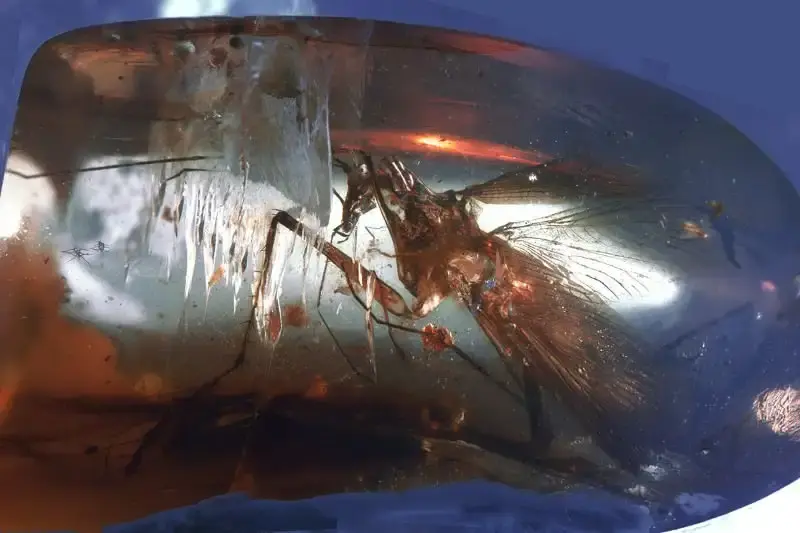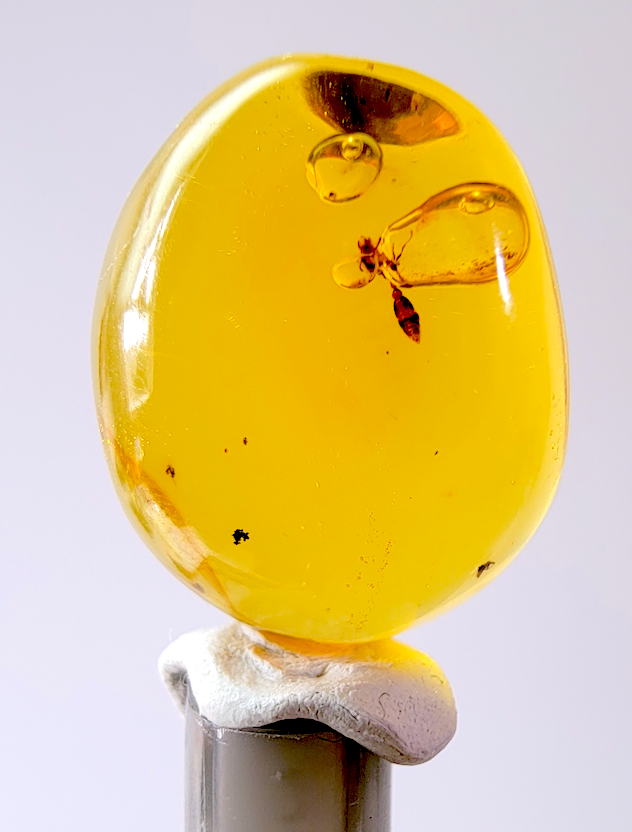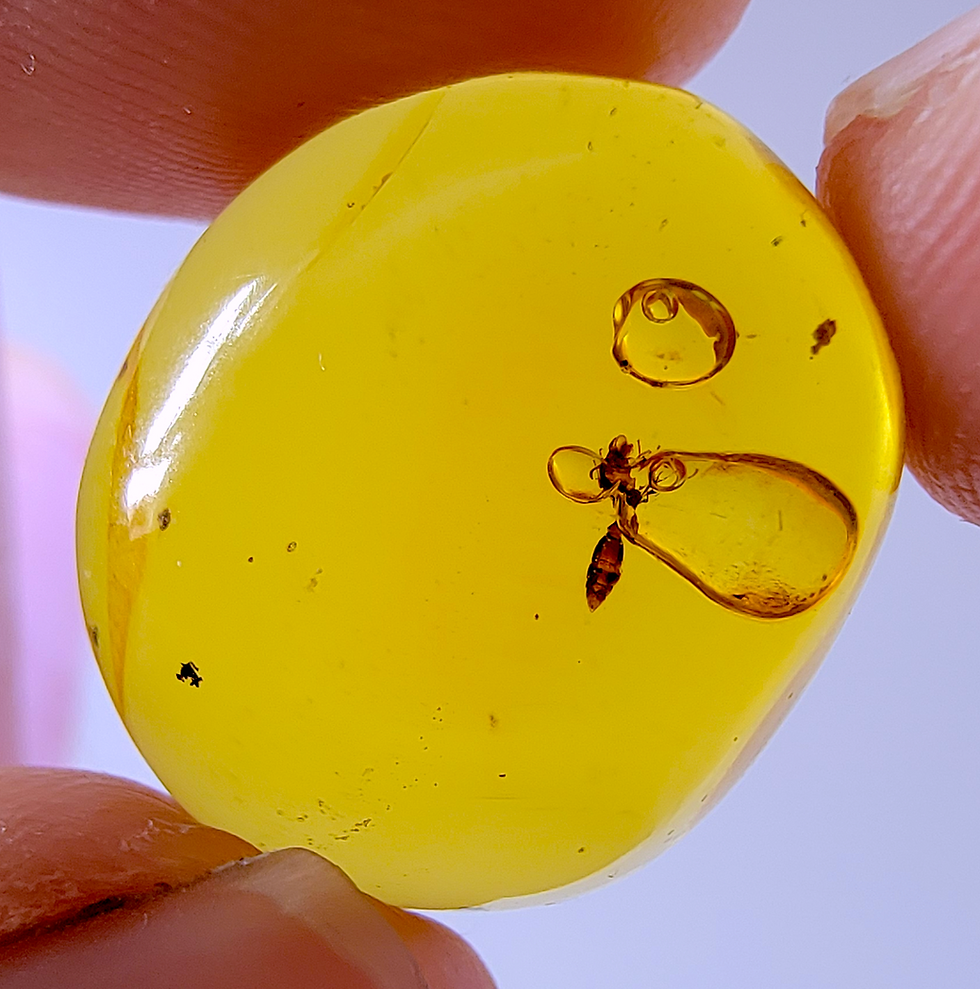Perfectly Preserved: The top 10 amber fossils
- Ryan Zschomler
- Aug 8
- 10 min read
Updated: 5 days ago
From time to time, paleontologists uncover amber fossils that stop us in our tracks. Not because of their size, but because they captured something never thought possible. Like a parasitic mushroom blooming out of an ant. Or a pair of feathers from an ancient mammal perfectly preserved In this article, we’ll look at ten standout amber specimens that provide an unparalleled window into ancient life.
Amber isn’t just a material for jewelry; its ability to entomb small bits of life has long helped scientists advance our fossil record. When a fresh drop of tree resin catches an insect or bits of plant material, it hardens over time and becomes a durable record of ecosystems millions of years old. Because of amber’s translucent quality, you can peer inside and see tiny creatures frozen in time—something no other fossil medium offers so clearly. In fact, amber is the only type of fossil that preserves the original material of the animal. All other fossils consist of material that has been replaced by minerals, or something else.
Insect inclusions are common, but amber sometimes preserves surprising guests: small vertebrates like lizards, frogs, or salamanders, along with delicate features such as feathers and hair. Researchers have even found insects caught in mid-courtship or plants locked in the midst of pollination. These discoveries give us direct evidence of how ancient species interacted and survived in their environments, allowing us to reconstruct prehistoric food webs and behaviors with more accuracy.
While resin preserves physical structures in exquisite detail, it can also capture genetic material. That means a real-world Jurassic Park scenario is possible. The only caveat is that the genetic material found thus far is damaged. So it is up to us to develop better technology to unlock the damaged DNA. Once we develop that technology, we will be able to do more. Maybe CRISPR will allow us to make the dream come true. Still, amber fossils have defined how we think about the history and evolution of small organisms. Some specimens date back to the time of early dinosaurs, over 230 million years ago, while others are a mere 20 million years old. The top 10 amber fossils showcase the most unique amber inclusions ever found.
# 1: PARASITIC FUNGI


We start off with a discovery that sounds like it was pulled straight out of science fiction: 100 Million years ago, a parasitic mushroom explodes out of a zombie-fly's head, and then they fall together into a wet resin that encased them forever. In the time of the dinosaurs, no less! In Burma's Kachin region, When paleontologists examined this piece, they didn’t just find well‑preserved insects; they found what can only be described as a prehistoric zombie show. The fungi belonged to Ophiocordyceps, the same family that inspired the “zombie‑ant fungus” in pop culture. It hijacked the insects’ bodies, drove them to their deaths, and then used their corpses to sprout its mushroom‑like fruiting bodies.
Using optical microscopes and micro‑CT scans, the research team reconstructed these tiny tableaux in astonishing detail. They even named the fungi: Paleoophiocordyceps burmanicae for the ant’s parasite, Paleoophiocordyceps ironomyiae for the fly’s.
This shows us that complex ecological relationships like parasitic fungi manipulating insect behavior existed long before mammals ruled the earth. In fact, these zombie fungi may have acted as predators, keeping insect populations in check. The discovery inevitably drew comparisons to HBO’s “The Last of Us,” with its cordyceps‑like outbreak.
# 2 : Venus-flytrap wasp


Imagine looking at a piece of amber and finding a wasp with what looks like a Venus flytrap jutting from its abdomen. This previously unknown wasp is now christened Sirenobethylus charybdis. They suspect this hinged, trap‑like appendage snapped shut on unsuspecting insects just long enough for the wasp to inject eggs. Once hatched, the larvae probably devoured their living hosts from the inside out, just like today’s parasitoid wasps.
The find left scientists scrambling for comparisons: there’s nothing like it among living insects, so they had to look all the way to carnivorous plants for a parallel. The amber itself came from Myanmar’s Kachin region and was donated to a Chinese university.
3: Possible dinosaur foot: https://www.amberbugs.com/post/amber-encyclopedia-entry-8-fossilized-lizard-foot-in-burmese-amber
There are fossils… and then there are fossils that stop you cold.
This Burmese amber specimen might look like just a tiny foot—but it could be one of the rarest windows into the Cretaceous forest you’ll ever see. What you’re looking at here is a partial fossilized foot, most likely from a juvenile reptile—but here’s the kicker: whether it belonged to a lizard or a bird, it still counts as dinosaur. Birds are dinosaurs. Lizards are diapsid reptiles, descended from the same early branches. So either way, we’re dealing with a dinosaurian lineage sealed in resin for 99 million years.
The claws are sharply curved, the digits still distinguishable. You can make out the skeletal outlines through the translucent Burmese amber, which dates back to the mid-Cretaceous. This isn’t your average insect inclusion. Vertebrate tissue in amber is almost unheard of. And when it does show up, it changes what we know about evolution.
To get trapped in tree resin as a small vertebrate, several things have to go wrong all at once. The animal has to be small, the resin fresh and sticky, the timing perfect. Maybe it fell from a branch. Maybe it was caught mid-hunt. Maybe it was being hunted. Whatever happened, it ended with this: a fossilized dinosaur foot, forever locked in amber. Lizard amber like this isn’t just rare, it’s almost mythical in the fossil trade. And in scientific circles, a specimen like this can spark new research into anatomy, locomotion, or even the evolution of scales and claws in prehistoric vertebrates.
4: Hell Ant

Sometimes amber preserves a startling prehistoric horror. This particular fossil is a hell ant frozen in mid-kill; its scythe‑like mandibles are clenched upward, pinning a cockroach-relative against a horn protruding from its forehead. Something no modern ant can do, as this species known as a "Hell Ant" is now extinct. The moment captured is raw behavior: An extinct predator killing it's prey.
This ant, Ceratomyrmex ellenbergeri, comes from the Haidomyrmecinae or “hell ant” lineage. Ants known for bizarre vertical jaws and horned heads. But this is the first specimen that confirms how they worked: the mandibles swung up, striking prey against the horn-like clypeal shield, effectively pinning it in place while the ant bit or stung. Behavior that, until this fossil emerged, was pure speculation.
This find isn’t just rare—it’s behaviorally rare. We don’t often get to see fossilized predation, especially involving insects. Insect interactions in amber are far more rare than insects all by themselves. And the holy grails of interactions are kills, and mating.
5: Manipulator roach: Extinct -

https://www.newscientist.com/article/dn27439-predatory-cockroach-from-dinosaur-era-found-trapped-in-amber/#.VUKTiyGqqko Manipulator modificaputis, which is now extinct, is a 100‑million‑year‑old cockroach preserved in Burmese amber that rewrote our assumptions about Cretaceous insects. this cockroach was a predator, built to hunt, with a freely rotating head, an elongated neck, and spindly legs suggesting pursuit behavior.
This cockroach is so unlike anything alive today that it warranted its own family: Manipulatoridae. It looked like a mantis-cockroach hybrid: head swiveling on a long neck, oversized maxillary palps, long forearms possibly used for grasping prey, and dense hairs on its legs that hint at a predatory lifestyle beneath the ancient conifer canopy.
Considered to be a pursuit predator, and adapted for flower visitation or even kleptoparasitism (stealing another insects food) in spider webs.
It’s the only known cockroach to blend predator morphology with amber preservation, unlike anything we find in modern Blattodea (Roaches and termites). All in all, it's a strange insect that no longer exists on this earth. Elongated neck, mantis-like movements, and it was locked forever in Myanmar’s Hukawng Valley. It challenges our expectations of cockroach evolution and behavior.
6: Chimera spider (Spider with tail):


Meet Chimerarachne yingi, now extinct. A 100‑million‑year‑old arachnid that looks like a spider… with a tail! And not just any tail, it's a whip‑like appendage several times the body’s length, something no modern spider has. This fossil is a time capsule of an evolutionary outlier caught mid-Cretaceous.
With spinnerets, fangs, and male pedipalps, Chimerarachne clearly spun silk like a spider. Yet it retains a segmented flagellum on its rear more like a scorpion, making it a chimera of arachnid traits and a missing link in spider evolution.
Somewhere between ancient Uraraneida and true spiders, Chimerarachne proves that tailed spider‑relatives lived alongside true web-weavers for at least 200 million years. Four specimens, each about 2.5 mm long (tail excluded), were found preserved in 3D detail with silk glands intact, tail dangling like a living antenna from a vanished world.
A spider‑like creature with a tail, bridging extinct body plans and modern spider lineage. It forces us to rethink what defines a spider, and showcases amber’s power to preserve morphology of hitherto unseen animals.
7:Bizarre alien looking insect:


Meet Aethiocarenus burmanicus—a 100‑million‑year‑old insect fossil from Myanmar’s Hukawng Valley—that looks like it stumbled from E.T.’s backyard. With a triangular, oblong head, bulging eyes, and a neck swivel giving it nearly 180° vision, this tiny bug is so alien it warranted its own order: Aethiocarenodea.
Paleontologists at Oregon State University ruled it so unique that it couldn’t fit into any of the 31 known insect orders—it became insect order #32. The flat-bodied female had long slender legs, likely scuttling over bark or lichen in search of mites, worms, or fungus while dinosaurs loomed nearby. Neck glands suggest it may have secreted chemicals to deter predators—adding biochemical shock to anatomical oddity.
Imagine a spider‑drop of amber that contains an insect with an alien head and repellent glands. Only a couple of specimens are known, making it rarer than dinosaur feathers in resin! This fossil isn’t just bizarre, it forces a redefinition of insect evolution, eye mechanics, and defensive chemistry in mid‑Cretaceous ecosystems.
it's a whole new branch of life, and only a few specimens have ever been found in amber.
8: Wasp enhydro:



Sometimes amber holds more than plants or animals, it holds prehistoric ecosystems. Surprisingly, water is one of the rarest inclusions of all. One such specimen from Dominican amber (Miocene, ~20 million years old) encloses not only a tiny wasp, a Dryinus rasnitsyni, but also a moving water bubble, known as an enhydro inclusion, with air swirling inside a tiny fluid cavity surrounded by the insect inclusion. This enhydro showcases great movement, which is key to know that the fluid has not dried up inside.
New World dryinid wasps, like Dryinus rasnitsyni, are blood-sucking or parasitic killers—but here, the wasp got trapped drinking water. And the bacteria in the amber have been drifting inside since for over 20 million years like a microscopic aquarium.
Dominican amber is famous for clarity, enabling exceptionally detailed views of insects. Still, finding a wasp preserved next to a fluid-filled cavity with a floating air droplet is extraordinarily rare. The enhydro bubble forms as resin traps a droplet of water and gas simultaneously, allowing it to move freely.
It combines rare preservation conditions, and the haunting beauty enhydros in amber. The presence of a Dryinus wasp alongside enhydro phenomena offers a multi-layered snapshot: insect anatomy, behavior, and paleo fluids dynamics in one golden package.
9: Bird foot found in amber:


https://www.earthtouchnews.com/discoveries/fossils/ancient-baby-bird-preserved-beautifully-in-amber/
Every now and again, amber doesn’t just preserve insects, it preserves birds. In this case, we’re talking about a baby bird that fell into tree resin about 99 million years ago in Myanmar’s Hukawng Valley and ended up with its entire head, one wing, both legs, feathered skin, and even part of its tail exquisitely preserved amber.
Nicknamed “Belone,” this diminutive enantiornithine hatchling was about 6 cm from snout to tail. It wasn’t just a bird—it was a half-feathered, toothed dinosaur cousin, hatched and ready to fly. Micro-CT scans revealed sheathed feathers mid-molt, claws on wing digits, eyelids, an ear opening, and even tiny tail “ribbon feathers” unique to early birds like enantiornithines.
What makes this inclusion perfect for your top‑ten list is how it freezes a transitional moment: a newborn ready for flight, juveniles that likely left the nest—and died—while climbing tree trunks or avoiding dinosaur predators. Belone represents independent early life, contrasting modern birds’ altricial infancy. The specimen’s condition and completeness make it one of the most anatomically informative dinosaur-era birds ever preserved in amber.
This fossil combines jaw-dropping preservation with evolutionary insight. It’s not just a feather in resin—it’s a window into hatchling behavior, feather development, and the ecological strategy of birds coexisting with dinosaurs.
For SEO-savvy readers searching amber fossils, baby bird in amber, Cretaceous birds, or enantiornithine hatchlings, this discovery hits all the keywords—and the emotional punch. A baby dinosaur-ancestor frozen mid-molt, mid-movement, and preserved in translucent time: it’s as haunting as it is scientifically invaluable.
10: Double feather in amber: https://www.amberbugs.com/post/the-beautiful-mystery-of-feathers-in-amber



You’re looking at a nearly 100-million-year-old Cretaceous-era feather, fossilized in Burmese amber clear enough to reveal microscopic detail and context for dinosaur evolution.
Picture a feather frozen in time, complete with a rare double rachis structure: two shafts running parallel, with interlocking barbicels that indicate advanced development—likely for flight or thermal control. That feature alone screams feather from a coelurosaur or feathered dinosaur, not just any bird ancestor.
The amber originated in Myanmar’s Hukawng Valley and dates to the mid-Cretaceous (~98–100 Ma). Feathers in resin are rare. Most aren’t visible enough to study. But this piece shows razor-sharp barbs, shaft symmetry, and even pigmentation variations that preserve melanosomes, opening the door to color reconstruction and evolutionary insight.
This isn’t a bug in resin. it’s a feathered dinosaur fragment preserved with museum-grade clarity. With collector-grade polish and verified context from extinct Burmese forests, this specimen transcends aesthetic oddity to become a scientific gem. It’s a clear line from dinosaurs to modern birds, frozen in amber.
For anyone writing around amber feathers, dinosaur feathers in amber, or Cretaceous avian structures, this specimen delivers visual poetry, scientific relevance, and evolutionary drama. It’s more than an inclusion, it’s proof of feathery dinosaur anatomy preserved in translucent time.
I hope you liked that. Try to find some more on www.amberbugs.com
OTHER INTERESTING TOPICS






Comments